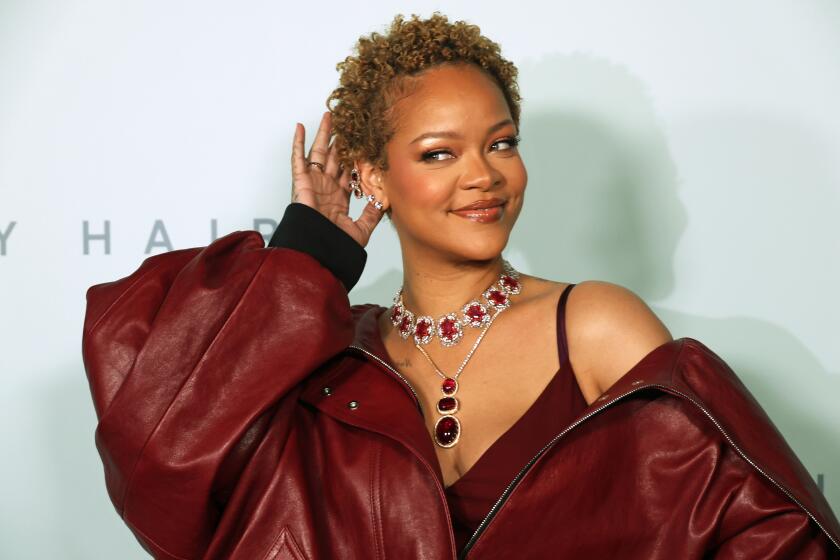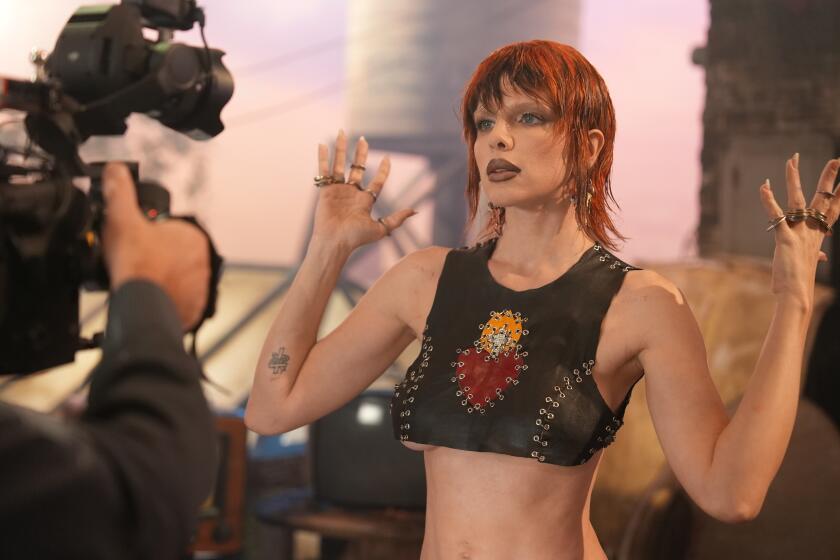Fur--The Real Thing--in Disguise : Fashion: Few designers have given up the ‘ultimate fabric.’ They’re bleaching it, shearing it and dyeing it to look like cloth. But others show only fake furs.
Back in the Stone Age, folks wore fur for a strictly functional reason--to keep warm. Several thousand years later, fur had evolved into a fashion statement that, along with diamonds and Rolls-Royces, conveyed classic style as well as wealth.
But icons are meant to be broken. And fur is no exception.
Recent years have seen the rise of the animal rights lobby, whose anti-cruelty campaigns tapped neatly into a burgeoning environmental movement. All of a sudden, many women conditioned to lust after mink coats began to question the validity of such trappings. With our newly heightened eco-consciousness, it seemed as if real fur fashion might be headed the way of the woolly mammoth.
Fur sales in Great Britain and Germany plummeted in the late 1980s. In the United States, the recession, warm winters and the animal rights movement have kept sales stagnant--less than $2 billion--for several years, industry experts say. Some old-time furriers have called it quits, and manufacturers say orders are down as much as 30% this fall.
But rumors of the fur industry’s death continue to be just that. While orders for outerwear are down, fur is making new inroads in the ready-to-wear industry, where it lines and accessorizes an increasing variety of clothes. And each fall, fashion magazines such as Vogue and Mirabella trot out the latest fur coat designs with the same gusto that the tabloids pursue Elizabeth Taylor.
In August, both magazines featured gushing layouts on the glories of fur. Last Sunday, a fur industry trade group ran an advertising spread in the New York Times Magazine featuring 20 top designers talking about why they use fur. Fur sales were up in Europe last winter, the Japanese market is booming, and industry mavens have high hopes that the American market will soon do the same.
Environmental consciousness notwithstanding, the truth is that more designers than ever are working with fur, including many in the ready-to-wear market, such as Donna Karan, Calvin Klein, Anne Klein and Marc Jacobs, who in his Perry Ellis collection last spring favored pink mink bomber jackets and cardigans.
“Fur is the ultimate fabric to work with because it’s the most luxurious,” says Donna Karan. But the designer “will never use an endangered species in any way, that’s her criteria,” says Patti Cohen, a Donna Karan Co. vice president.
Furriers say there is growing demand for fur-lined and -accented garments as well as for reversible coats. But the industry mainstay remains outerwear--coats, wraps and jackets. So, in an attempt to increase sales, designers are getting away from the sleek pelt coats of yesteryear. Instead, they are bleaching, shearing and dyeing furs to look like cloth. Harlequin patterns, plaids and fluorescent colors debuted in the spring collections in New York. The sheared mink coats--many of them dyed garish hues--look and feel like velour.
Why would someone take a pricey mink and shear it to look like velour?
“It’s newness, it’s something that’s different. The traditional old-lady mink coat is dead,” says Steve Perlo, senior executive vice president for Birger Christensen, a New York fur manufacturer.
Most top fur manufacturers hire well-known names such as Karl Lagerfeld, Bob Mackie and Oscar de la Renta to design their lines. Birger Christensen, for instance, has licensing agreements with such labels as Perry Ellis, Mackie and Claude Montana, among others.
But because any industry that generates almost $2 billion in annual sales wields substantial clout, it’s difficult to find fashion insiders who will speak frankly about fur. “I don’t want to comment at the moment,” says Hanae Mori, whose elegant, luxurious fur designs have taken Japan and the United States by storm.
Even designers who don’t work in fur take pains to maintain an even demeanor.
Norma Kamali “prefers working with fake furs. It’s not any political statement, it’s just by preference,” says a spokeswoman for the designer.
Italian designers Giorgio Armani and Franco Moschino have sworn off real fur.
Bill Blass, Carolina Herrera and Geoffrey Beene are heavyweight American designers who have announced in the past two years that they will no longer use fur. But they decline to elaborate.
Carolina Herrera “doesn’t say anything for or against it. It was a decision she made, a personal decision, and that’s all she ever says,” a Herrera spokeswoman says.
Ditto for Bill Blass, who, after his contract with a furrier expired, quit using it for “personal reasons.” “He is not aligning himself with any groups for or against, and he has absolutely no other comment,” a Blass spokesman says.
One designer who does speak candidly about wrestling with his fur demons is Oscar de la Renta.
“I know there’s great cruelty about how these animals are farmed and killed, but so is there cruelty in how chickens are killed,” De la Renta says. “The (leather) belts and shoes we wear (once) belonged to an animal.
“It’s very difficult to come to terms with what’s correct. It’s a question of soul-searching and you make the decision on your own. I used to use fox and sable,” he says. “Today I use only farmed animals, so that tells you where my thinking lies.”
Perhaps the clearest winner in the fracas has been the fake fur industry. Long relegated to a quiet, behind-the-scenes role in which manufacturers tried to make their synthetics look like The Real Thing, fake fur has dropped all pretexts and come boisterously out of the closet.
Besides gaining a strong market niche, fake fur has hit the high fashion runways in collections by Sonia Rykiel as well as Armani and Moschino. Advocates tout fake fur as inexpensive, ecological, lightweight and dry-cleanable.
There’s also a practical reason to let people know you’re wearing a faux fur. Animal rights activists have reportedly shattered windows of furriers, splashed wearers with red paint and followed them down the street hissing “murderer.”
In Los Angeles, where fur is as much for fashion as warmth, Wachtenheim Furs president Daniel Wachtenheim says some of his clients are celebrities who wouldn’t be caught wearing fur in public.
But others sport their furs proudly.
“Sometimes I think people give me a funny look,” says Brenda Gordon of Reseda, an entrepreneur and fur coat owner. “But I’ll be damned if I’m going to wear anything else. When I dress up, I like wearing something really nice that makes me feel good.”
Gordon says the recession has made her think twice about splurging on another coat, and that concern is reflected in manufacturer orders, which are down 20% to 30% this fall.
But furriers point out that sales of other luxury items also are down. And they rush to be optimistic. “We feel furs are poised for growth. There’s a pent-up demand among people,” says Bill Outlaw of the Fur Information Council of America, a lobbying group.
He may be right. Wholesale prices for mink pelts are up 30% to 40% after plummeting about 50% several years ago because of over-production. Sales in Spain, Italy and Asia are up. Japan is also a growing consumer, gobbling up to one-quarter of U.S. fur exports.
All this, despite the flowering of the animal rights lobby in the late 1980s, when furriers began keeping a low profile and tightening security. The industry reportedly spent $2 million fighting negative publicity, although furriers downplay the impact of animal rights activists.
The activists, on the other hand, believe they have changed public awareness about furs.
“Certainly fashion designers are creative enough, we think, to come up with alternatives,” says Jenine de Shazer, media relations director for People for the Ethical Treatment of Animals (PETA), which claims 400,000 members.
“It’s no longer fashionable to wear what used to be a living, breathing animal. It’s the symbol of death, not fashion, and the public is becoming more and more educated and conscientious,” says de Shazer, who contends that farmed animals are mistreated and ill-fed.
Furriers respond that ranchers have a vested interest in quality care because humanely treated animals yield glossier pelts. About 75% of animals whose pelts become furs are raised on ranches, says Sandra Blye of the American Fur Industry, a trade group.
And furriers also say polls indicate that American women are weary of being lectured on what is acceptable clothing.
Barbara Keeler of La Crescenta, who owns coats of mink, fox and beaver, is one such consumer.
“I have a right to wear whatever I want,” says Keeler, who owns a crafts shop and cherishes her furs. “They’re soft, they’re warm and they look good. I’m not afraid to wear them out.”



